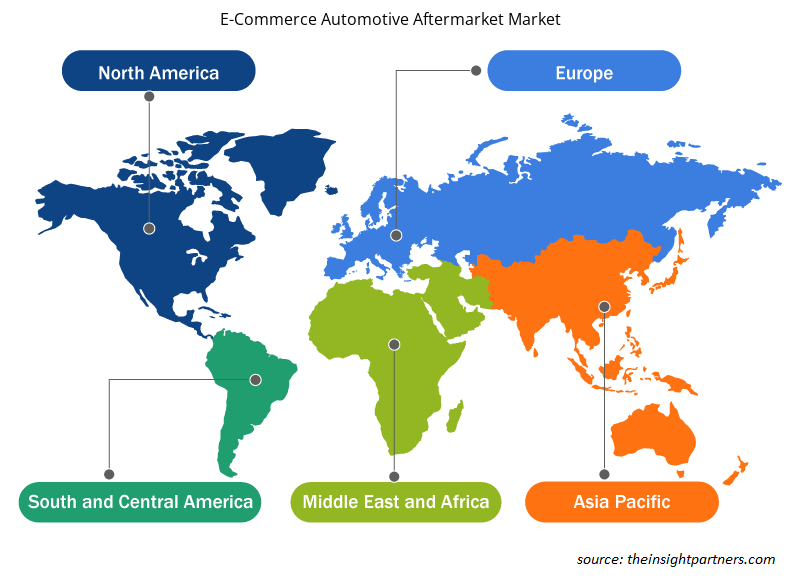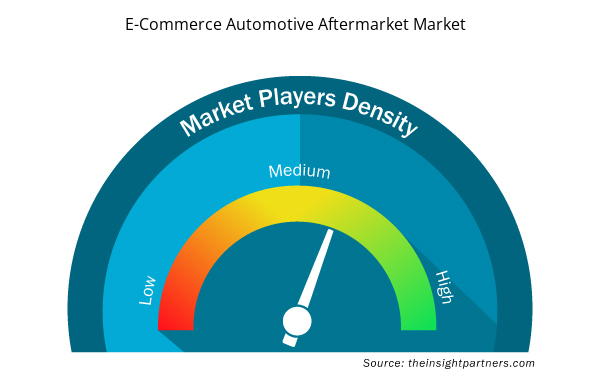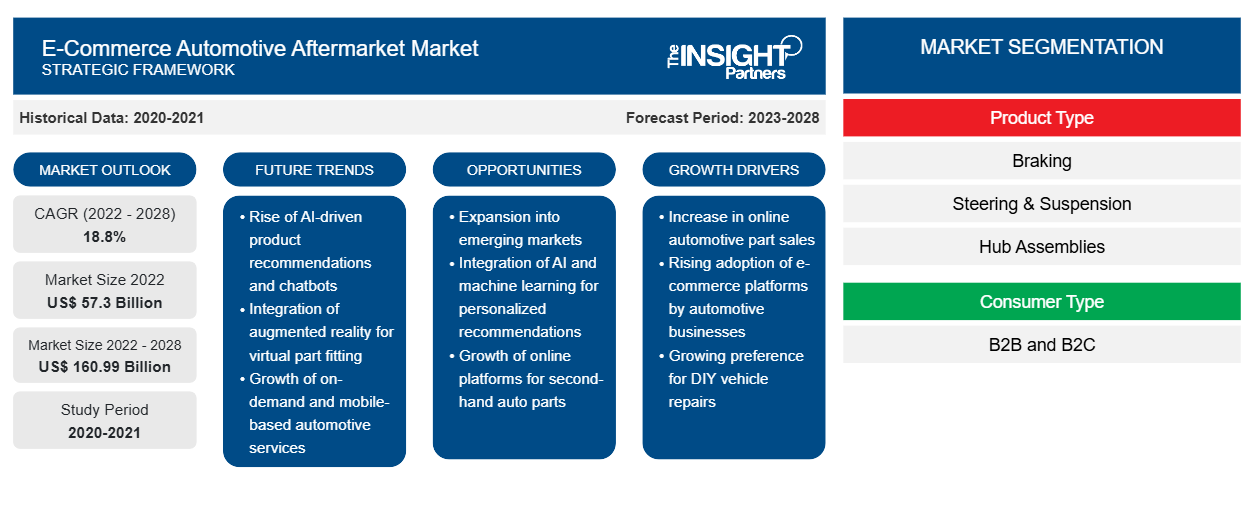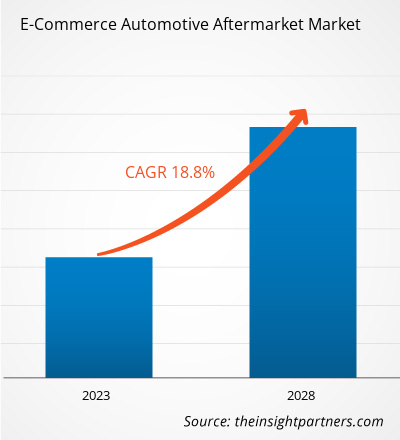電子商取引の自動車アフターマーケット市場は、2022年の573億110万米ドルから2028年には1609億8540万米ドルに成長すると予想されています。2022年から2028年にかけて18.8%のCAGRで成長すると予測されています。
北米は商用車の継続的な生産により、自動車産業が発達しています。国際自動車工業会(OICA )の2021年の報告書によると、米国は2021年に7,604,154台、2020年に6,895,604台、2019年に8,367,239台の商用車を生産しました。同様に、カナダはOICAの2021年の報告書によると、2021年に826,767台、2020年に1,048,942台、2019年に1,455,215台の商用車を生産しました。同じ報告書によると、メキシコは2021年に合計2,437,411台、2020年に2,209,121台、2019年に2,604,080台の商用車を生産しました。OICA の統計によると、米国、カナダ、メキシコは世界の商用車生産部門をリードしています。したがって、この地域での商用車の継続的な生産は、北米の電子商取引自動車アフターマーケット市場の成長を支えています。
COVID-19パンデミックが電子商取引自動車アフターマーケット市場に与える影響
北米では、米国、カナダ、メキシコでCOVID-19の症例数が大幅に増加しました。2020年のCOVID-19パンデミックの発生後、多くの製造工場が閉鎖され、自治体の機能は減速し、自動車および半導体産業の操業は中止されました。この地域では、COVID-19パンデミックによる米国とカナダのさまざまな生産施設と倉庫の閉鎖によって引き起こされたバリューチェーンの中断が、短期的な需要、物流インフラ、製品在庫に即座に影響を及ぼしました。しかし、自動車業界は、サービス、修理、交換に関してオンラインチャネルが提供する独自のサービスにより、成長を続けました。COVID-19パンデミックの発生前は、eコマースが急速に拡大していました。しかし、パンデミックにより、オンラインプラットフォームを使用する米国の消費者の数が増加し、より多くのお金を使うようになりました。これらの活動により、自動車機器メーカーがeコマースに特化したアフターマーケット販売に従事することを可能にする、よく組織化されたeコマースエコシステムが浸透し、大きな収益シェアを獲得しました。2021年4月、米国とカナダのeコマース自動車アフターマーケット市場における自動車部品、パーツ、アクセサリーの売上は、2020年と比較して60%以上増加しました。
要件に合わせてレポートをカスタマイズする
このレポートの一部、国レベルの分析、Excelデータパックなど、あらゆるレポートを無料でカスタマイズできます。また、スタートアップや大学向けのお得なオファーや割引もご利用いただけます。
- このレポートの主要な市場動向を入手してください。この無料サンプルには、市場動向から見積もりや予測に至るまでのデータ分析が含まれます。
Eコマース自動車アフターマーケット市場インサイト
DIYおよびDIFM消費者の増加
Amazon と eBay は、多くの場所で自動車アフターマーケットの即日配送を行っています。Robert Bosch GmbH、Denso Corp.、Magna International Inc.、Continental AG、ZF Friedrichshafen AG など、いくつかの大手部品メーカーと取引関係があり、取り付けサービスを提供しています。従来の自動車部品サプライヤーは、DIY 目的で自動車アフターマーケットのコンポーネントを購入する顧客が、従来の自動車部品サプライヤーではなく、デジタル e コマース Web サイトに移行する最初のセグメントであることを知っています。したがって、商業業者や技術者と一貫したビジネスを維持することは、競争力を維持するための独自の戦略です。最新の自動車の標準機能には、車線変更を検知するセンサー、360° カメラ、専門家の支援を必要とするテクノロジーが含まれます。
DIFM(Do-it-for-me )トレンドでは、高級車を所有する消費者は、自動車修理業者や整備士に頼るようになると予想されます。たとえば、Advance Auto Partsは、運転支援技術の機能を提供することで、eコマースを利用してこれらの市場グループを独自にターゲットにしています。競合他社がこの収益性の高いeコマース自動車アフターマーケット市場を追求し続ける中、eコマース自動車アフターマーケット市場は、デジタルB2C(ビジネスツーコンシューマー)、B2B(ビジネスツービジネス)マーケットプレイス、およびこれらのマーケットプレイスをサポートする成長を続けるサプライチェーンを活用し続ける必要があります。その結果、eコマース自動車部門で自動車部品のオンライン購入を採用する顧客数の増加により、eコマース自動車アフターマーケット市場に新たな機会が生まれることが期待されます。
製品タイプ別の市場分析
製品タイプに基づいて、eコマース自動車アフターマーケット市場は、ブレーキ(ブレーキパッド、油圧およびハードウェア、ローターおよびドラム)、ステアリングおよびサスペンション(ボールジョイント、タイロッド、スタビライザーリンク、ベアリング/シールなど)、ハブアセンブリ、ユニバーサルジョイント、ガスケット、フィルター、スパークプラグなどに分類されます。 2021年には、その他セグメントがeコマース自動車アフターマーケット市場をリードし、市場で最大のシェアを占めました。
消費者タイプに基づく市場分析
消費者タイプに基づいて、eコマース自動車アフターマーケット市場はB2BとB2Cに分割されています。2021年には、B2Cセグメントがeコマース自動車アフターマーケット市場をリードし、より大きな市場シェアを占めました。
市場プレーヤーは、合併、買収、市場イニシアチブなどの戦略を採用して、電子商取引自動車アフターマーケット市場での地位を維持しています。主要プレーヤーによるいくつかの開発を以下に示します。
- 2022年3月、大手OE部品メーカーであるデンソーのアフターマーケット子会社であるデンソーアフターマーケットは、大手グローバル購買組織であるGroupAuto Internationalから、名誉ある2021年サプライヤーオブザイヤー賞を受賞しました。
- 2020年9月、LKQコーポレーションは、チェコの自動車部品卸売業者2社の株式をスイス・オートモーティブ・グループAGに売却するという、以前に発表された取引を完了した。取引条件は明らかにされていない。
Eコマース自動車アフターマーケットレポートの範囲
Eコマース自動車アフターマーケット市場地域別インサイト
予測期間を通じて E コマース自動車アフターマーケット市場に影響を与える地域的な傾向と要因は、Insight Partners のアナリストによって徹底的に説明されています。このセクションでは、北米、ヨーロッパ、アジア太平洋、中東、アフリカ、南米、中米にわたる E コマース自動車アフターマーケット市場のセグメントと地理についても説明します。

- Eコマース自動車アフターマーケット市場の地域別データを入手
Eコマース自動車アフターマーケット市場レポートの範囲
| レポート属性 | 詳細 |
|---|---|
| 2022年の市場規模 | 573億米ドル |
| 2028年までの市場規模 | 1,609.9億米ドル |
| 世界のCAGR(2022年 - 2028年) | 18.8% |
| 履歴データ | 2020-2021 |
| 予測期間 | 2023-2028 |
| 対象セグメント | 製品タイプ別
|
| 対象地域と国 | 北米
|
| 市場リーダーと主要企業プロフィール |
|
市場プレーヤーの密度:ビジネスダイナミクスへの影響を理解する
Eコマース自動車アフターマーケット市場は、消費者の嗜好の変化、技術の進歩、製品の利点に対する認識の高まりなどの要因により、エンドユーザーの需要が高まり、急速に成長しています。需要が高まるにつれて、企業は提供内容を拡大し、消費者のニーズを満たすために革新し、新たなトレンドを活用し、市場の成長をさらに促進しています。
市場プレーヤー密度とは、特定の市場または業界内で活動している企業または会社の分布を指します。これは、特定の市場スペースに、その市場規模または総市場価値に対してどれだけの競合相手 (市場プレーヤー) が存在するかを示します。
Eコマース自動車アフターマーケット市場で事業を展開している主要企業は次のとおりです。
- アリババグループホールディングス
- Amazon.com, Inc.
- オートゾーン株式会社
- ショップ365
- CATI SpA
免責事項:上記の企業は、特定の順序でランク付けされていません。

- Eコマース自動車アフターマーケット市場のトップキープレーヤーの概要を入手
企業プロフィール
Alibaba Group Holding Limited、Amazon.com, Inc.、AutoZone, Inc.、Shopee365、CATI SpA、eBay Inc.、LKQ Corporation、The Pep Boys、CarParts.com, Inc、およびDenso Corporationは、主要な市場プレーヤーです。
- 過去2年間の分析、基準年、CAGRによる予測(7年間)
- PEST分析とSWOT分析
- 市場規模価値/数量 - 世界、地域、国
- 業界と競争環境
- Excel データセット



Report Coverage
Revenue forecast, Company Analysis, Industry landscape, Growth factors, and Trends

Segment Covered
This text is related
to segments covered.

Regional Scope
North America, Europe, Asia Pacific, Middle East & Africa, South & Central America

Country Scope
This text is related
to country scope.
よくある質問
Rising number of e-commerce providers and increased replacement rates boost B2C industry are driving the growth of the e-commerce automotive aftermarket market.
Increasing customer awareness for automotive aftermarket is presenting significant potential for the future growth of the e-commerce automotive aftermarket market players.
APAC is the fastest growing region in the global e-commerce automotive aftermarket market.
Based on product type, the e-commerce automotive aftermarket market is segmented into braking, steering and suspension, hub assemblies, universal joints, gaskets, filters, spark plug, and others. In 2021, the others segment led the e-commerce automotive aftermarket market, accounting for the largest share in the market.
The incremental growth of the e-commerce automotive aftermarket market during the forecast period of 2022-2028 is US$ 103,684.37 million.
The major five companies in the e-commerce automotive aftermarket market include Alibaba Group Holding Limited; Amazon.com, Inc.; AutoZone, Inc.; LKQ Corporation; and CarParts.com, Inc.
Trends and growth analysis reports related to Automotive and Transportation : READ MORE..
The List of Companies - E-Commerce Automotive Aftermarket Market
- Alibaba Group Holding Limited
- Amazon.com, Inc.
- AutoZone, Inc.
- Shopee365
- CATI S.p.A.
- eBay Inc.
- LKQ Corporation
- The Pep Boys
- CarParts.com, Inc
- Denso Corporation
The Insight Partners performs research in 4 major stages: Data Collection & Secondary Research, Primary Research, Data Analysis and Data Triangulation & Final Review.
- Data Collection and Secondary Research:
As a market research and consulting firm operating from a decade, we have published and advised several client across the globe. First step for any study will start with an assessment of currently available data and insights from existing reports. Further, historical and current market information is collected from Investor Presentations, Annual Reports, SEC Filings, etc., and other information related to company’s performance and market positioning are gathered from Paid Databases (Factiva, Hoovers, and Reuters) and various other publications available in public domain.
Several associations trade associates, technical forums, institutes, societies and organization are accessed to gain technical as well as market related insights through their publications such as research papers, blogs and press releases related to the studies are referred to get cues about the market. Further, white papers, journals, magazines, and other news articles published in last 3 years are scrutinized and analyzed to understand the current market trends.
- Primary Research:
The primarily interview analysis comprise of data obtained from industry participants interview and answers to survey questions gathered by in-house primary team.
For primary research, interviews are conducted with industry experts/CEOs/Marketing Managers/VPs/Subject Matter Experts from both demand and supply side to get a 360-degree view of the market. The primary team conducts several interviews based on the complexity of the markets to understand the various market trends and dynamics which makes research more credible and precise.
A typical research interview fulfils the following functions:
- Provides first-hand information on the market size, market trends, growth trends, competitive landscape, and outlook
- Validates and strengthens in-house secondary research findings
- Develops the analysis team’s expertise and market understanding
Primary research involves email interactions and telephone interviews for each market, category, segment, and sub-segment across geographies. The participants who typically take part in such a process include, but are not limited to:
- Industry participants: VPs, business development managers, market intelligence managers and national sales managers
- Outside experts: Valuation experts, research analysts and key opinion leaders specializing in the electronics and semiconductor industry.
Below is the breakup of our primary respondents by company, designation, and region:

Once we receive the confirmation from primary research sources or primary respondents, we finalize the base year market estimation and forecast the data as per the macroeconomic and microeconomic factors assessed during data collection.
- Data Analysis:
Once data is validated through both secondary as well as primary respondents, we finalize the market estimations by hypothesis formulation and factor analysis at regional and country level.
- Macro-Economic Factor Analysis:
We analyse macroeconomic indicators such the gross domestic product (GDP), increase in the demand for goods and services across industries, technological advancement, regional economic growth, governmental policies, the influence of COVID-19, PEST analysis, and other aspects. This analysis aids in setting benchmarks for various nations/regions and approximating market splits. Additionally, the general trend of the aforementioned components aid in determining the market's development possibilities.
- Country Level Data:
Various factors that are especially aligned to the country are taken into account to determine the market size for a certain area and country, including the presence of vendors, such as headquarters and offices, the country's GDP, demand patterns, and industry growth. To comprehend the market dynamics for the nation, a number of growth variables, inhibitors, application areas, and current market trends are researched. The aforementioned elements aid in determining the country's overall market's growth potential.
- Company Profile:
The “Table of Contents” is formulated by listing and analyzing more than 25 - 30 companies operating in the market ecosystem across geographies. However, we profile only 10 companies as a standard practice in our syndicate reports. These 10 companies comprise leading, emerging, and regional players. Nonetheless, our analysis is not restricted to the 10 listed companies, we also analyze other companies present in the market to develop a holistic view and understand the prevailing trends. The “Company Profiles” section in the report covers key facts, business description, products & services, financial information, SWOT analysis, and key developments. The financial information presented is extracted from the annual reports and official documents of the publicly listed companies. Upon collecting the information for the sections of respective companies, we verify them via various primary sources and then compile the data in respective company profiles. The company level information helps us in deriving the base number as well as in forecasting the market size.
- Developing Base Number:
Aggregation of sales statistics (2020-2022) and macro-economic factor, and other secondary and primary research insights are utilized to arrive at base number and related market shares for 2022. The data gaps are identified in this step and relevant market data is analyzed, collected from paid primary interviews or databases. On finalizing the base year market size, forecasts are developed on the basis of macro-economic, industry and market growth factors and company level analysis.
- Data Triangulation and Final Review:
The market findings and base year market size calculations are validated from supply as well as demand side. Demand side validations are based on macro-economic factor analysis and benchmarks for respective regions and countries. In case of supply side validations, revenues of major companies are estimated (in case not available) based on industry benchmark, approximate number of employees, product portfolio, and primary interviews revenues are gathered. Further revenue from target product/service segment is assessed to avoid overshooting of market statistics. In case of heavy deviations between supply and demand side values, all thes steps are repeated to achieve synchronization.
We follow an iterative model, wherein we share our research findings with Subject Matter Experts (SME’s) and Key Opinion Leaders (KOLs) until consensus view of the market is not formulated – this model negates any drastic deviation in the opinions of experts. Only validated and universally acceptable research findings are quoted in our reports.
We have important check points that we use to validate our research findings – which we call – data triangulation, where we validate the information, we generate from secondary sources with primary interviews and then we re-validate with our internal data bases and Subject matter experts. This comprehensive model enables us to deliver high quality, reliable data in shortest possible time.


 このレポートの無料サンプルを入手する
このレポートの無料サンプルを入手する